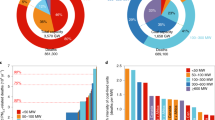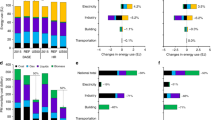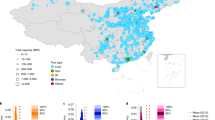Abstract
Carbon dioxide emissions standards for US power plants will influence the fuels and technologies used to generate electricity, alter emissions of pollutants such as sulphur dioxide and nitrogen oxide, and influence ambient air quality and public health. We present an analysis of how three alternative scenarios for US power plant carbon standards could change fine particulate matter and ozone concentrations in ambient air, and the resulting public health co-benefits. The results underscore that carbon standards to curb global climate change can also provide immediate local and regional health co-benefits, but the magnitude depends on the design of the standards. A stringent but flexible policy that counts demand-side energy efficiency towards compliance yields the greatest health benefits of the three scenarios analysed.
This is a preview of subscription content, access via your institution
Access options
Subscribe to this journal
Receive 12 print issues and online access
$209.00 per year
only $17.42 per issue
Buy this article
- Purchase on Springer Link
- Instant access to full article PDF
Prices may be subject to local taxes which are calculated during checkout




Similar content being viewed by others
References
Carbon Pollution Emission Guidelines for Existing Stationary Sources: Electric Utility Generating Units 79 FR 34829 (US EPA, 2014); https://federalregister.gov/a/2014-13726
National Greenhouse Gas Emissions and Sinks: 1990–2013 Publication No. 430-R-14–003 (US EPA, 2014); http://go.nature.com/GSeOar
Annual Energy Outlook 2014 with Projections to 2040 (DOE/EIA, 2014); http://go.nature.com/BPZObe
Regulatory Impact Analysis for the Proposed Carbon Pollution Guidelines for Existing Power Plants and Emission Standards for Modified and Reconstructed Power Plants Publication No. EPA-452/R-14-002 (US EPA, 2014); http://go.nature.com/M5JBzy
Jerrett, M. et al. Long-term ozone exposure and mortality. New Engl. J. Med. 360, 1085–1095 (2009).
Fann, N. et al. Estimating the national public health burden associated with exposure to ambient PM2.5 and ozone. Risk Anal. 32, 81–95 (2012).
Burtraw, D., Linn, J., Palmer, K. & Paul, A. The costs and consequences of greenhouse gas regulation under the Clean Air Act. Am. Econ. Rev. 104, 557–562 (2014).
Muller, N. Z. & Mendelsohn, R. Efficient pollution regulation: Getting the prices right. Am. Econ. Rev. 99, 1714–1739 (2009).
Fraas, A. & Lutter, R. Efficient pollution regulation: Getting the prices right: Comment. Am. Econ. Rev. 102, 602–607 (2012).
The Benefits and Costs of the Clean Air Act from 1990 to 2020 (US EPA, 2011); http://www.epa.gov/cleanairactbenefits/feb11/summaryreport.pdf
Regulatory Impact Analysis for the Final Mercury and Air Toxics Standards Publication No. EPA-452/R-11-011 (US EPA, 2011); http://go.nature.com/6cBliV
Population by Single Year of Age (Woods & Poole Economics, 2008).
HCUPnet, Healthcare Cost and Utilization Project (Agency for Healthcare Research and Quality, 2007).
Acknowledgements
Financial support for this work was provided by the William and Flora Hewlett Foundation, the Grantham Foundation and Mistra's Indigo Program. The authors thank colleagues M. Weiss, K. Driscoll, M. Hale, J. Macedonia, S. Pan, S. Sekar and S. Yeh.
Author information
Authors and Affiliations
Corresponding author
Ethics declarations
Competing interests
The authors declare no competing financial interests.
Supplementary information
Supplementary Information
Supplementary information (PDF 1074 kb)
Rights and permissions
About this article
Cite this article
Driscoll, C., Buonocore, J., Levy, J. et al. US power plant carbon standards and clean air and health co-benefits. Nature Clim Change 5, 535–540 (2015). https://doi.org/10.1038/nclimate2598
Received:
Accepted:
Published:
Issue Date:
DOI: https://doi.org/10.1038/nclimate2598
This article is cited by
-
Nuclear power generation phase-outs redistribute US air quality and climate-related mortality risk
Nature Energy (2023)
-
Effects of global climate mitigation on regional air quality and health
Nature Sustainability (2023)
-
Air quality and health benefits of increasing carbon mitigation tech-innovation in China
Environmental Science and Pollution Research (2023)
-
Does the low-carbon city pilot contribute to the blue sky defense? Evidence from China
Environmental Science and Pollution Research (2023)
-
Integrating sustainability into climate finance by quantifying the co-benefits and market impact of carbon projects
Communications Earth & Environment (2022)



